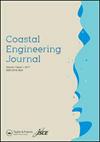加拿大太平洋海岸cascadia俯冲地震的随机震源模拟和海啸模拟
IF 1.9
3区 工程技术
Q3 ENGINEERING, CIVIL
引用次数: 3
摘要
摘要本研究提出了太平洋西北部卡斯卡迪亚俯冲地震的新随机震源模型,该地震可在温哥华岛海岸线引发大规模海啸。针对8.1至9.1之间的矩震级范围,生成了一组5000个随机震源模型,并以270m的网格分辨率进行了区域海啸灾害模拟。随机海啸模拟的结果通过评估基于温哥华岛沿岸最大波高几何平均值的区域海啸危险性指标来表征。随后,利用区域海啸灾害参数的概率分布,通过捕捉平均和罕见的破裂情况来识别具有代表性的震源模型,然后检查详细的海啸灾害结果,如特定位置的最大波高图和波浪剖面。数值结果突出了海啸发生和波浪传播对加拿大太平洋沿岸海啸灾害的方向性影响,以及断层几何形状和地震滑移分布方面的震源特征。所开发的震源模型和海啸模拟结果是对卡斯卡迪亚俯冲带进行概率海啸危险分析的第一步。本文章由计算机程序翻译,如有差异,请以英文原文为准。
Stochastic source modeling and tsunami simulations of cascadia subduction earthquakes for Canadian Pacific coast
ABSTRACT This study presents new stochastic source models for the Cascadia subduction earthquakes in the Pacific Northwest, which can trigger massive tsunamis along the shoreline of Vancouver Island. An extensive set of 5,000 stochastic source models is generated for the moment magnitude ranges between 8.1 and 9.1, and regional tsunami hazard simulations are performed at the grid resolution of 270 m. The results from the stochastic tsunami simulations are characterized by evaluating the regional tsunami hazard metric that is based on the geometric mean of the maximum wave heights along the Vancouver Island coast. Subsequently, using the probability distribution of the regional tsunami hazard parameter, representative source models are identified by capturing the average as well as rare rupture cases and then detailed tsunami hazard results, such as maximum wave height maps and wave profiles at specific locations, are examined. Numerical results highlight the directivity effects of tsunami generation and wave propagation on tsunami hazards along the Canadian Pacific coast and the earthquake source characterizations in terms of fault geometry and earthquake slip distribution. The developed source models and tsunami simulation results serve as the first step for performing probabilistic tsunami hazard analysis for the Cascadia subduction zone.
求助全文
通过发布文献求助,成功后即可免费获取论文全文。
去求助
来源期刊

Coastal Engineering Journal
工程技术-工程:大洋
CiteScore
4.60
自引率
8.30%
发文量
0
审稿时长
7.5 months
期刊介绍:
Coastal Engineering Journal is a peer-reviewed medium for the publication of research achievements and engineering practices in the fields of coastal, harbor and offshore engineering. The CEJ editors welcome original papers and comprehensive reviews on waves and currents, sediment motion and morphodynamics, as well as on structures and facilities. Reports on conceptual developments and predictive methods of environmental processes are also published. Topics also include hard and soft technologies related to coastal zone development, shore protection, and prevention or mitigation of coastal disasters. The journal is intended to cover not only fundamental studies on analytical models, numerical computation and laboratory experiments, but also results of field measurements and case studies of real projects.
 求助内容:
求助内容: 应助结果提醒方式:
应助结果提醒方式:


